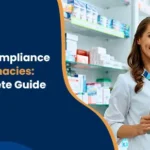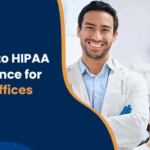HIPAA Pharmacy Compliance: Updates and Best Practices

November 21, 2025
Staying compliant with the Health Insurance Portability and Accountability Act (HIPAA) is more critical than ever for pharmacies. With evolving privacy rules, new technology requirements, and ongoing staff training needs, even small compliance gaps can lead to costly violations. With the December 2024 Federal Register update, covered entities will face $386.3 million in costs as they switch to new National Council for Prescription Drug Programs (NCPDP) retail pharmacy standards.
In this guide, you’ll get a clear breakdown of HIPAA pharmacy compliance, critical new rule updates, and hands-on steps to help pharmacies prevent violations and keep patient information protected.
What Are the Latest HIPAA Pharmacy Compliance Standards?
Pharmacies are on the front lines when it comes to protecting patient health details. That means regulations around privacy and security are a huge part of daily pharmacy life. The HIPAA, first passed back in 1996, continues to set the ground rules for how pharmacies should handle protected health information, or PHI.
With HIPAA pharmacy compliance, pharmacies aren’t just managing prescriptions – they’re also bound by strict federal rules at every turn, from processing insurance claims to keeping conversations private at the counter. Even a small slip, like talking too loudly about a patient’s medication, can quickly lead to a pharmacy HIPAA violation.
2024 Updates: The NCPDP F6 Transition
In December 2024, the Department of Health and Human Services (HHS) finalized an update to the administrative simplification rules, requiring pharmacies to transition from the long-standing NCPDP Telecommunication Standard Version D.0 to Version F6. This shift means upgrading your pharmacy’s technology, updating security protocols, and retraining staff – all while still serving patients.
But HIPAA pharmacy compliance isn’t just about technology. It’s about setting up a privacy-first culture, where every staff member knows the protocols for handling prescriptions, discussing treatments, and storing paperwork. Pharmacies that take compliance seriously help build trust with patients, streamline their operations, and stay clear of costly penalties. As the rules keep changing, pharmacies must stay flexible, update procedures, and make security a daily habit.
Quick win: Consider running short, spontaneous ‘privacy audits’ where you watch for common slip-ups – like staff discussing prescriptions within earshot of others. Address issues in real time to improve awareness and nip risky habits before they become problems.
How Do HIPAA Pharmacy Rules Keep Patient Information Safe?
HIPAA pharmacy rules work by creating a three-part safety net:
- The Privacy Rule
- The Security Rule
- The Breach Notification Rule
The Privacy Rule
The Privacy Rule controls how pharmacies use and share private patient information. That means only people who actually need access – like the pharmacist, an authorized caregiver, or a doctor treating the patient – can see medication or insurance details. Anything beyond this usually requires the patient’s okay.
The Security Rule
The Security Rule makes sure both electronic PHI (ePHI)and paper records are protected. Pharmacies need to lock up files, put passwords on systems, and restrict who can get near prescription info. It covers everything from computers at the front counter to the break room where charts are stored.
The Breach Notification Rule
If someone does get unauthorized access to PHI, the Breach Notification Rule says you have to tell affected patients and alert the Department of Health and Human Services (HHS). If a big breach happens (500 people or more), you’ll also need to let the media know. Smaller incidents go in a yearly report to HHS. For details, check the HHS basics guide.
What Compliance Looks Like in Everyday Pharmacy Operations
Every pharmacy – no matter its size – also has to post HIPAA policies, give patients access to their health records, and make sure staff are trained regularly. That means even an independent store follows the same rules as a national chain. Compliance isn’t optional; it’s the foundation for ethical practice and earning patient trust.
Helpful trick: Place discreet reminders about privacy in staff-only areas (near time clocks or workstations). Reminders by workstations or time clock stations can prompt everyone to double-check before sharing or accessing PHI, so compliance becomes almost second nature.
| HIPAA Rule | What It Does | Key Pharmacy Actions |
| Privacy Rule | Controls how pharmacies can use and share private patient info. | Only allow access to those who need it (pharmacists, caregivers, treating doctors); get patient consent for other uses. |
| Security Rule | Protects electronic and paper records from unauthorized access or breaches. | Lock up files, use passwords, limit physical/electronic access, secure all prescription info. |
| Breach Notification Rule | Requires pharmacies to notify patients, HHS, and sometimes media if PHI is breached. | Report breaches promptly, inform patients, document incidents, and ensure staff training. |
What Are the Most Common Pharmacy HIPAA Violations?
Pharmacy HIPAA violations can come from honest mistakes or bigger system problems.
The most frequent issues include:
- Discussing patient details where others can hear.
- Leaving out prescription bags or paperwork for anyone to see.
- Staff checking records not related to their job.
- Weak computer security, like bad passwords or old software firewalls.
The Cost of Noncompliance
The consequences are serious, According to the HHS Office for Civil Rights (OCR), over 20,000 HIPAA investigations have led to fines, public penalty notices, and sometimes even criminal charges. That kind of attention can really damage a pharmacy’s reputation and relationships with the community.
So, why do violations happen? Lack of regular staff training is behind a lot of these problems. Team members who don’t know the rules are more likely to make mistakes with PHI. Not reporting breaches quickly (within the required 60-day window) escalates penalties. And in today’s digital world, errors – big or small – leave a digital trail, so the best defense is ongoing, practical compliance education.
Prevention Tips for Pharmacies
Don’t forget to refresh your risk assessments at least once a year – or after any big changes in staff or technology. Sometimes, inviting a neutral third party to look for overlooked weak spots can uncover issues you might miss after seeing the same setup daily.
How Can Pharmacies Prevent HIPAA Violations and Stay Compliant?
Staying compliant with HIPAA isn’t just a one-time fix. Pharmacies need a sustainable, thorough plan.
Assign Responsibility and Train Staff
Start by naming a HIPAA Privacy Officer to keep tabs on compliance day-to-day. Every employee – from technicians to cashiers – should get detailed training, including what to do in tricky situations, like emergencies or insurance problems at the counter. Refresh training regularly to keep up with new regulations, such as the 2024 NCPDP F6 transition.
Safeguard Electronic and Paper Records
Secure your data by updating antivirus software, enabling firewalls, and using strong, unique passwords for each staff member. Make sure only people who absolutely need access can see patient records, and keep logs (or audit trails) showing who’s opened or changed files.
Physical safeguards matter too, such as:
- Keeping prescription bins out of public sight.
- Adding privacy screens at registers or pickup areas.
- Locking up files and storage rooms.
Monitor, Maintain, and Respond
Document all training and incident responses carefully. If a breach happens, act fast – notify authorities, inform patients, and start fixing any vulnerabilities. Make sure your technology regularly gets updates, especially for new requirements like the 2024 NCPDP standards. Hold yearly reviews and run practice drills to identify weak spots early.
When HIPAA compliance is built into everyday routines, patient privacy is stronger – and your pharmacy keeps risk low.
Involve Staff in Compliance
Frontline employees often notice risks, such as a poorly placed counter or missing privacy barriers, before management does. It also pays to ask staff for feedback about possible privacy gaps. Sometimes, the people on the ground spot risks,like awkward counter setups or missing privacy screens, long before management does. Involve them regularly to fine-tune your defense.
What Does Ongoing HIPAA Compliance Look Like for Pharmacies?
HIPAA pharmacy compliance isn’t static, it evolves alongside technology, healthcare delivery models, and regulatory updates.
The upcoming shift to NCPDP Version F6 – required for Medicaid agencies by 2028 (according to the December 2024 Federal Register) – means pharmacies need to keep up with technological and data standard changes.
Upfront costs will be significant. The update estimates spending $386.3 million across all covered entities, but there are benefits: fewer paperwork errors, faster claims processing, and better workflows overall. To stay compliant, pharmacies should:
- Stay updated on both federal and state HIPAA and NCPDP milestones.
- Revise staff education programs often to update evolving rules.
- Build strong partnerships with IT vendors to handle system upgrades and security needs.
- Be active in pharmacy professional organizations to stay informed about compliance trends.
New Challenges: Telepharmacy and Remote Care
Remote care and telepharmacy are growing, which brings HIPAA into new territory. Protecting patient information in cloud-based and mobile environments needs the same care as at the counter. Pharmacies that stay a step ahead with HIPAA rules not only avoid violations; they also build a reputation as trusted healthcare partners in their communities.
It’s smart to assign someone to track industry news or subscribe to compliance alerts from HHS, OCR, and state boards. Rapid updates mean you won’t get caught off guard, and your team can handle new technology or legal tweaks without scrambling at the last minute.
Conclusion
To sum up, HIPAA pharmacy compliance is not just a checklist item. It’s the backbone of safe, ethical, and trustworthy care in every pharmacy. By keeping up with changing laws, giving your staff strong training, and making compliance a daily routine, you protect both patient data and your reputation.
Keep a close eye on new regulations, review your policies frequently, and don’t hesitate to consult experts when the rules get complicated. By focusing on privacy and security at every step, you build a pharmacy where both patients and staff feel safe.
Read More: HIPAA Dental Compliance for Offices
FAQs
Q: What are the main HIPAA pharmacy compliance requirements?
A: HIPAA pharmacy compliance requires pharmacies to protect patient information privacy, secure health data, and follow strict breach notification rules. Pharmacies must also provide patients access to their health information and report violations to relevant authorities.
Q: What is the deadline for pharmacies to update to the new NCPDP standards?
A: Pharmacies must move to the updated NCPDP Version F6 standard for electronic transactions by February 11, 2028, to meet HIPAA pharmacy compliance rules. State Medicaid agencies face the same deadline for system updates.
Q: How do pharmacy HIPAA violations get reported and enforced?
A: When a pharmacy HIPAA violation occurs, pharmacies must report it to the HHS Office for Civil Rights. Enforcement includes civil and criminal penalties, and the details of violations become part of the public record, affecting a pharmacy’s reputation.
Q: What happens if a pharmacy experiences a small PHI breach?
A: For breaches affecting fewer than 500 patients, pharmacies must submit the incident to the Department of Health and Human Services annually. Larger or immediate threats require rapid notification, usually no later than 60 days after discovery.





